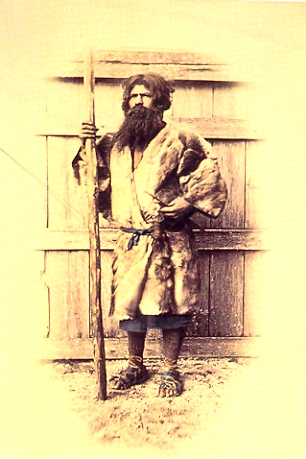
Posted on 12/08/2008 4:58:57 PM PST by BGHater
The Ainu are the indigenous people of Japan, inhabiting the Northern island of Hokkaido as well as the Kuril Islands and Sakhalin. Their name means “human”, or more accurately the opposite of the gods that inhabit all plants, objects, and animals in their heavily animistic religion.

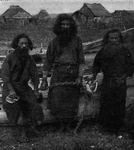
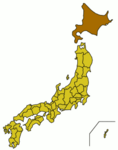

Thought to once inhabit all of Japan, the Ainu were pushed northward by the influx of immigration from Asia that occurred primarily during the Yayoi period of Japanese history around 2,300 years ago.
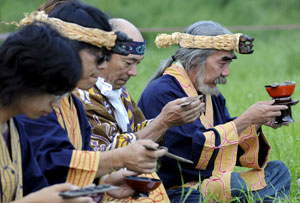
The Ainu have faced a long history of oppression and hardship. Throughout the modern era, they have faced active assimilation, forced labor, and the repression of their cultural identity and customs. During the height of the Japanese government’s assimilation policy in the 1800s, the Ainu were banned from observing daily customs and were labelled as “former aboriginal people,” and it was not until 1997 that they were even recognized as an indigenous minority group at all.
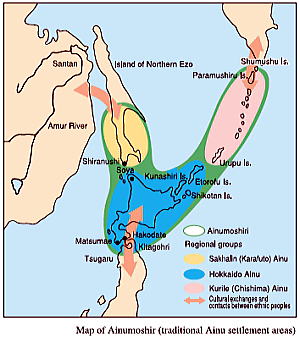
It is estimated that there are around 20,000 to 60,000 people (many of mixed race) who identify themselves as Ainu today, although the accuracy of these numbers is questionable due to the fact that for a long time Japanese census records made no distinction between Ainu and ethnic Japanese, as well as the tendency for many to hide their ancestry due to rampant discrimination in some areas. There could be as many as ten times more than that according to some.

Shown is an Ainu woman with a traditional lips tattoo. Almost all woman had these tattoos done upon reaching adulthood, which was 15 or 16 by Ainu standards. The tattoos are believed to increase beauty and gain better prospects for marriage, as well as being a sort of rite of passage into womanhood.
Besides the political controversy of the plight of the Ainu people, they have also raised other debates within anthropology and hominology. One such debate is that of the very origins and history of this people. Ainu are very different in physical appearance than ethnic Japanese and other Asian peoples. Taller than average Japanese, the Ainu typically have a long skull, light complexion, heavy facial hair, and Caucasian features. Their hair tends to be thick and wavy, and body hair is also more pronounced. Aside from the physical differences, the Ainu language is also quite unique, showing no relation to Japanese or other Asian languages. These unique differences have posed an often debated mystery. Who are the Ainu and where did they come from?


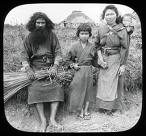
Early anthropologists were fascinated by the Ainu and made much of the physical differences that existed between Ainu and Japanese. These early researchers often exaggerated these physical qualities, and suggested that they were evidence of Caucasian ancestry. The Ainu were said to be a sort of “lost Caucasian race”. However, there is no genetic evidence of this and it is considered an outdated theory. The mystery remained however, since it was obvious that the Ainu people and ethnic Japanese were of different origins.
There are many current ideas on the origins of the Ainu people. Some suggest that the same prehistoric group of people that produced the Australian aborigines, a sort of “Oceania race,” also inhabited the Japanese archipelago before the Jomon period of Japan (14,000 to 2,500 years ago). This is based on fossils dating back 10,000 years that seem to show similarities with the indigenous people of Australia and New Zealand.
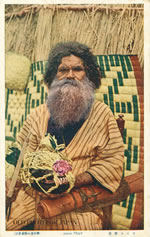
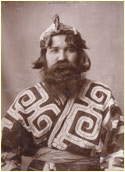


Others say that the Ainu are descendants of people of mongoloid stock from Northeast and central Asia, who migrated to Japan before the Jomon period. Genetic evidence seems to support this theory, since DNA tests on Ainu showed that many showed a relationship to the people of Tibet and the Adaman Islands of the Indian Ocean, and one in eight Ainu men were shown to exhibit genetic traits most common to the Russian far east and Mongolia.

There are other ideas too, such as that the Ainu represent a completely unique group of people, or an ancient Asian race, but the question of the exact origins of the Ainu remains unresolved.
The mystery of the Ainu does not end with their origins, however. One hotly debated topic that only adds to the mystery of Ainu history is the notion that they may have even been among the first peoples to inhabit North America. The epicenter of the debate swirling around this theory, and the best evidence for it, is a curious piece of fossil evidence called the Kennewick Man.
+++ Read part II on this contribution on Monday, “The Ainu and The Kennewick Man” by Brent Swancer, December 8, 2008.
The Ainu and the Kennewick Man -Part 2
The Kennewick Man, also sometimes referred to as the Richland Man, is a skeleton which was accidentally found at the Lake Wahulla section of the Columbia River in Kennewick, Washington on July 28, 1996. The skeleton was in remarkably good condition, missing only the sternum and some bones in the hands and feet.
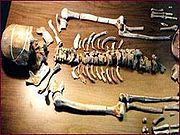
Upon examination, it was found that the skeleton lacked many distinctive features found in Native Americans, and exhibited some Caucasian features as well. In addition to features of the skull and bones, the condition of the teeth suggested a diet different from the Native Americans. For these reasons, it was thought that the remains were perhaps that of an early European explorer, however the mystery would only deepen upon further analysis.
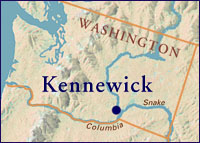
Through preliminary radio carbon dating, it was found that the remains were around 9,000 years old. Also, a projectile tip of a type used from around 8,500 BP to 4,500BP was found lodged in the hip. It seemed that this was no European explorer, but rather a stone age individual with characteristics unlike the later Native Americans. Anthropologists and paleontologists rushed in to do more detailed examinations and try to determine the nature of these mysterious remains. Upon comparing the remains to 18 modern populations of humans, it was determined that the ancestry most closely resembled that of the Ainu.

The study of the Kennewick Man remains has long been embroiled in controversy. The remains were originally taken possession of by the U.S. Army Corps of engineers, who own the land on which the remains were found, however this was immediately challenged in court by the NAGPRA (Native American Graves Protection and Repatriation Act). NAGPRA states that any human remains found on federal lands that are found to be affiliated with a Native tribe can be claimed by that tribe.
Several tribes claimed the remains as their own and demanded their return for a proper burial. This was quickly opposed by a group of archeologists and anthropologists who claimed that NAGPRA did not apply in this case. And so the long legal battles surrounding the Kennewick man started, often holding up studies and even bringing research on the remains to a halt. Examination was halted in 1996 due to court battles and debates with Native tribes, only to resume again in 1998.
Scientific studies that were done on the skeleton from 1998 to 2000 were frequently dogged by legal woes, and it wasn’t until 2002 that a federal court ruled that NAGPRA did not apply to the remains as a cultural link was not met, and this allowed scientists better access to the remains. This ruling was upheld again in 2004, but the firestorm of controversy and legal motions are far from over. Currently, the skeleton is being held at the Burke Museum at the University of Washington, and is legally designated as the property of the U.S. Army Corps of Engineers.
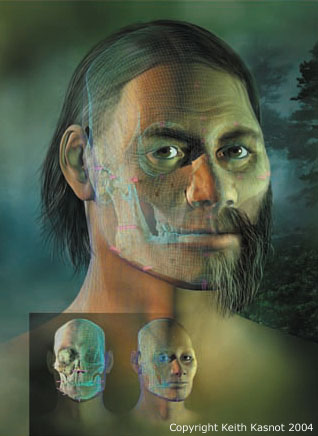
To date, despite the legal controversy, the Kennewick Man remains have been physically examined on various occasions using standard scientific methods and techniques, and some things have been gleaned from it. It is known that the man was between 45 and 55 years old, around 5′9″ in height, was muscular, and had received various injuries that appear to have healed before death. In addition, evidence suggests that the body was deliberately buried rather than left exposed to the elements. Yet the mystery of who this man was or where he came from remains as mysterious as ever. In 2006, results of studies performed on the remains in 2005 supported the earlier notion that these remains closely matched features found in the Ainu people.
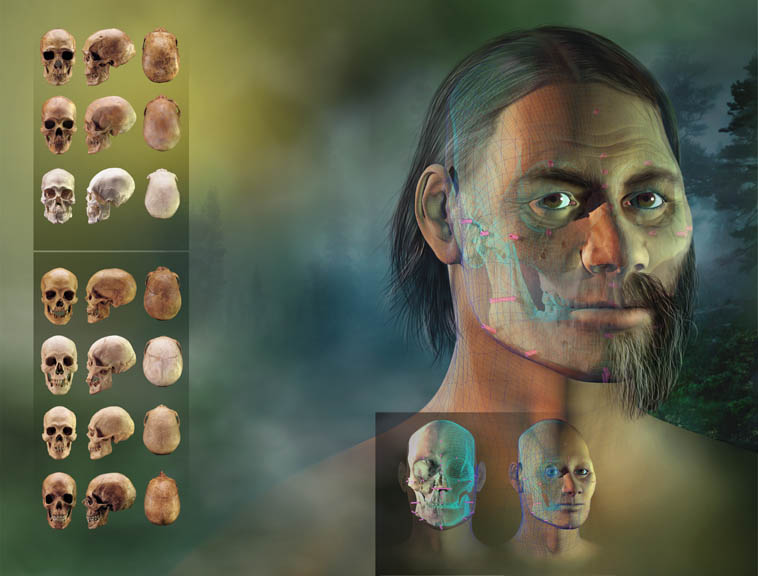
So is it possible that Ainu were some of the first humans to inhabit North America? The theory certainly has its share of detractors. Some insist that there are not enough samples to make any assumptions on the origins of the remains. They are quick to point out that the physical differences of a single specimen don’t mean anything in the larger picture and therefore the Kennewick Man is useless as evidence of anything. Others point to the greater physical diversity between individuals in remains dating over 8,000 years old, or even point to the blurry lines of race to begin with. It could be argued that human populations are not unambiguous or clearly separated biological groups so therefore any divisions made between biological populations are subjective and arbitrary, especially when looking at 9,000 years old bones.
The debate goes on, but the essential mystery remains. Who was Kennewick man? Further analysis of the remains may yield more answers, but if it is indeed the skeleton of an Ainu as speculated, then this would shake to the core our current conventional understanding of how and by whom the continent was first settled.
Footnote from Loren:
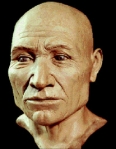
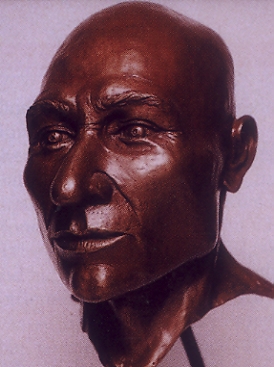
One of the first forensic reconstructions from the skull of the Kennewick Man looked extremely familiar to those who viewed it soon after its completion.

Very familiar.
Ainu ping.
bfltr, sounds interesting. For some reason, some of the images remind me of the aboriginal people of Australia. Shows all of us are a lot more connected than we often think.
Ainu it!
Ainu bump
I have noticed one sometimes sees a Japanese who looks fairly European.
If that last pic is related to Kennewick Man and Kennewick Man is related to the Ainu it would mean the Ainu are French which in turn explains why they have been so poorly treated by the Japanese.
Or they have similar ancestor branches. I would love to see the DNA tracing on the relationship.

...the Eno people...

...or the Uno people...

With the discovery of those Caucasian, or Caucasian mix mummies found in China, it is easy for me to believe that back in the day, people got around.
I, too, would love to see that DNA tracing.
http://www.freerepublic.com/tag/ainu/index
Origins Of The Ainu
Nova/PBS | 2-2-2006 | Gary Crawford
Posted on 02/02/2006 4:16:59 PM PST by blam
http://www.freerepublic.com/focus/f-news/1570558/posts
|
|
|||
Gods |
Thanks BGHater. |
||
|
· Discover · Nat Geographic · Texas AM Anthro News · Yahoo Anthro & Archaeo · · The Archaeology Channel · Excerpt, or Link only? · cgk's list of ping lists · |
|||
google:Ainu and the Pleiadians- a little goofy but if you like outerspace that’s for you :)
The medieval shoguns were “barbarian-fighting generals.” Who were the “barbarians”? Ainu or another group?
Refer to blam, he’s the resident Ainu expert.
Which Shogunate? There was more than one...
Muawiyah has some interesting ideas about the Ainu too.
The oldest human remains found in the Americas were recently "discovered" in the storeroom of Mexico's National Museum of Anthropology. Found in central Mexico in 1959, the five skulls were radiocarbon dated by a team of researchers from the United Kingdom and Mexico and found to be 13,000 years old. They pre-date the Clovis culture by a couple thousand years, adding to the growing evidence against the Clovis-first model for the first peopling of the Americas.
Of additional significance is the shape of the skulls, which are described as long and narrow, very unlike those of modern Native Americans.
[snip]
Yes, there were several families of shoguns, starting in the Middle Ages, with the last family (Tokugawa) being deprived of power as late as the 1860s, but the original meaning of the term reportedly was “barbarian-fighting general.”
Disclaimer: Opinions posted on Free Republic are those of the individual posters and do not necessarily represent the opinion of Free Republic or its management. All materials posted herein are protected by copyright law and the exemption for fair use of copyrighted works.